Orangutan
Orangutans (also spelled orang-utan, orangutang, or orang-utang) are great apes native to Indonesia and Malaysia. They are found in the rainforests of Borneo and Sumatra, but during the Pleistocene they ranged throughout Southeast Asia and South China. Classified in the genus Pongo, orangutans were originally considered to be one species. From 1996, they were divided into two species: the Bornean orangutan (P. pygmaeus, with three subspecies) and the Sumatran orangutan (P. abelii). In 2017, a third species, the Tapanuli orangutan (P. tapanuliensis), was identified. The orangutans are the only surviving species of the subfamily Ponginae, who split from humans, chimpanzees and gorillas 19.3 to 15.7 million years ago (mya).
| Orangutans | |
|---|---|
| Bornean orangutan (Pongo pygmaeus) | |
| Scientific classification | |
| Kingdom: | Animalia |
| Phylum: | Chordata |
| Class: | Mammalia |
| Order: | Primates |
| Suborder: | Haplorhini |
| Infraorder: | Simiiformes |
| Family: | Hominidae |
| Subfamily: | Ponginae |
| Genus: | Pongo Lacépède, 1799 |
| Type species | |
| Pongo pygmaeus Lacépède, 1799 (Simia satyrus Linnaeus, 1760) | |
| Species | |
|
Pongo pygmaeus | |
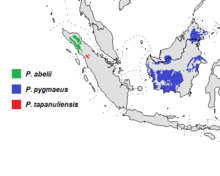 | |
| Range of the three extant species | |
| Synonyms | |
|
Faunus Oken, 1816 | |
The most arboreal of the great apes, orangutans spend most of their time in trees. They have proportionally long arms and short legs and their hair is reddish-brown. Adult males may develop distinctive cheek pads or flanges and make long calls that attract females and intimidate rivals; younger males do not and resemble adult females. Orangutans are the most solitary of the great apes, social bonds occurring primarily between mothers and their dependent offspring, who remain together for the first two years. Fruit is the most important component of an orangutan's diet, but the apes will also eat vegetation, bark, honey, insects and bird eggs. They can live over 30 years both in the wild and in captivity.
Orangutans are among the most intelligent primates. They use a variety of sophisticated tools and construct elaborate sleeping nests each night from branches and foliage. The apes' learning abilities have been studied extensively. There may be distinctive cultures within populations. Orangutans have been featured in literature and art since at least the 18th century, particularly in works which comment on human society. Field studies of the apes were pioneered by primatologist Birutė Galdikas and they have been kept in captive facilities around the world since at least the early 19th century. All three orangutan species are considered critically endangered. Human activities have caused severe declines in populations and ranges. Threats to wild orangutan populations include poaching, habitat destruction because of palm oil cultivation, and the illegal pet trade. Several conservation and rehabilitation organisations are dedicated to the survival of orangutans in the wild.
Etymology

The name "orangutan" (also written orang-utan, orang utan, orangutang, and ourang-outang[1]) is derived from the Malay words orang, meaning "man", and hutan, meaning "forest".[2] The locals originally used the name to refer to actual forest-dwelling people.[3]
The first attestation of the word for the apes is in Dutch physician Jacobus Bontius' 1631 Historiae naturalis et medicae Indiae orientalis. He reported that Malays had informed him the ape could talk, but preferred not to "lest he be compelled to labour".[4] The word appeared in several German-language descriptions of Indonesian zoology in the 17th century. The likely origin of the word comes specifically from the Banjarese variety of Malay.[3] Cribb and colleagues (2014) suggest that Bontius' account referred not to apes (as this description was from Java were the apes were not known from) but to humans suffering some serious medical condition (most likely cretinism) and that his use of the word was misunderstood by Nicolaes Tulp, who was the first to use the term in a publication a decade later.[5]:10–18
The word was first attested in English in 1691 in the form orang-outang, and variants ending with -ng are found in many languages. This spelling (and pronunciation) has remained in use in English up to the present but has come to be regarded as incorrect.[6][7][8] The loss of "h" in Utan and the shift from -ng to -n has been taken to suggest the term entered English through Portuguese.[3] In Malay, the term was first attested in 1840, not as an indigenous name but referring to how the English called the animal.[9] The word 'orangutan' in Malay and Indonesian today was borrowed from English or Dutch in the 20th century—explaining why the initial 'h' of 'hutan' is also missing.[3]
The name of the genus, Pongo, comes from a 16th-century account by Andrew Battel, an English sailor held prisoner by the Portuguese in Angola, which describes two anthropoid "monsters" named Pongo and Engeco. He is now believed to have been describing gorillas, but in the 18th century, the terms orangutan and pongo were used for all great apes. French naturalist Bernard Germain de Lacépède used the term Pongo for the genus in 1799.[10][5]:24–25 Battel's "Pongo", in turn, is from the Kongo word mpongi[11][12] or other cognates from the region: Lumbu pungu, Vili mpungu, or Yombi yimpungu.[13]
Taxonomy and phylogeny
The orangutan was first described scientifically in 1758 in the Systema Naturae of Carl Linnaeus as Simia satyrus.[5]:20 It was renamed Simia pygmaeus in 1760 by his student Christian Emmanuel Hopp and given the name Pongo by Lacépède in 1799.[5]:24–25 The populations on the two islands were suggested to be separate species when P. abelii was described by French naturalist René Lesson in 1827.[14] In 2001, P. abelii was confirmed as a full species based on molecular evidence published in 1996,[15][16]:53[17] and three distinct populations on Borneo were elevated to subspecies (P. p. pygmaeus, P. p. morio and P. p. wurmbii).[18] The description in 2017 of a third species, P. tapanuliensis, from Sumatra south of Lake Toba, came with a surprising twist: it is more closely related to the Bornean species, P. pygmaeus than to its fellow Sumatran species, P. abelii.[17]
.jpg)
The Sumatran orangutan genome was sequenced in January 2011.[19][20] Following humans and chimpanzees, the Sumatran orangutan became the third species of great ape to have its genome sequenced. Subsequently, the Bornean species had its genome sequenced. Genetic diversity was found to be lower in Bornean orangutans (P. pygmaeus) than in Sumatran ones (P. abelii), despite the fact that Borneo is home to six or seven times as many orangutans as Sumatra. The researchers hope these data may help conservationists save the endangered ape, and also prove useful in further understanding of human genetic diseases.[20] Similarly to gorillas and chimpanzees, orangutans have 48 diploid chromosomes, in contrast to humans, which have 46.[21]:9
Within apes (superfamily Hominoidea), the gibbons diverged during the early Miocene (between 24.1 and 19.7 mya, according to molecular evidence) and the orangutans split from the African great ape lineage between 19.3 and 15.7 mya. Israfil and colleagues (2011) estimated based on mitochondrial, Y-linked, and X-linked loci that the Sumatran and Borean species diverged 4.9 to 2.9 mya.[22](Fig. 4) By contrast, the 2011 genome study suggested that these two species diverged around 400,000 years ago, more recently than was previously thought. Also, the orangutan genome was found to have evolved much more slowly than chimpanzee and human DNA.[20] A 2017 genome study found that the Bornean and Tapanuli orangutans diverged from Sumatran orangutans about 3.4 mya, and from each other around 2.4 mya. Orangutans travelled from Sumatra to Borneo as the islands were connected by land bridges as parts of Sundaland during recent glacial periods when sea levels were much lower. The present range of Tapanuli orangutans is thought to be close to where ancestral orangutans first entered what is now Indonesia from mainland Asia.[17][23]
| Taxonomy of genus Pongo[24] | Phylogeny of superfamily Hominoidea[22](Fig. 4) | |||||||||||||||||||||||||||
|---|---|---|---|---|---|---|---|---|---|---|---|---|---|---|---|---|---|---|---|---|---|---|---|---|---|---|---|---|
Genus Pongo
|
|
Fossil record
The three orangutan species are the only extant members of the subfamily Ponginae. This subfamily also included the extinct genera Lufengpithecus, which lived in southern China and Thailand 8–2 mya,[16]:50 Indopithecus, which lived in India from 9.2–8.6 mya; and Sivapithecus, which lived in India and Pakistan from 12.5 mya until 8.5 mya.[25] These apes likely lived in drier and cooler environments than orangutans do today. Khoratpithecus piriyai, which lived in Thailand 5–7 mya, is believed to be the closest known relative of the orangutans.[16]:50 The largest known primate, Gigantopithecus, was also a member of Ponginae and lived in China, from 2 mya to 300,000 years ago.[26][16]:50
The oldest known record of Pongo is from the Early Pleistocene of Chongzuo, consisting of teeth ascribed to extinct species P. weidenreichi.[27][28] Pongo is found as part of the faunal complex in the Pleistocene cave assemblage in Vietnam, alongside Giganopithecus, though it is known only from teeth. Some fossils described under the name P. hooijeri have been found in Vietnam, and multiple fossil subspecies have been described from several parts of southeastern Asia. It is unclear if these belong to P. pygmaeus or P. abelii or, in fact, represent distinct species.[29] During the Pleistocene, Pongo had a far more extensive range than at present, extending throughout Sundaland and mainland Southeast Asia and South China. Teeth of orangutans are known from Peninsular Malaysia that date to 60,000 years ago. The range of orangutans had contracted significantly by the end of the Pleistocene, most likely because of the reduction of forest habitat during the Last Glacial Maximum.Though they may have survived into the Holocene in Cambodia and Vietnam.[27][30]
Characteristics
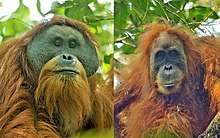
Orangutans display significant sexual dimorphism; females typically stand 115 cm (3 ft 9 in) tall and weigh around 37 kg (82 lb), while flanged adult males stand 137 cm (4 ft 6 in) tall and weigh 75 kg (165 lb). Compared to humans, they have proportionally long arms, a male orangutan having an arm span of about 2 m (6.6 ft), and short legs. Most of their bodies are covered in coarse hair that is generally red but ranges from bright orange to maroon or dark chocolate, while the skin is grey-black. Though largely hairless, males' faces can develop some hair, giving them a beard.[31][32][16]:14
Orangutans have small ears and noses; the ears are unlobed.[31] The mean endocranial volume is 397 cm3.[33] The braincase is elevated relative to the facial area, which is concave and prognathous.[31] Compared to chimpanzees and gorillas, the brow ridge of an orangutan is underdeveloped.[34] Females and juveniles have rounded skulls and narrow faces while males develop a large sagittal crest and large cheek pads or flanges,[31] which show their dominance to other males. The cheek pads are made mostly of fatty tissue and are supported by the musculature of the face.[35] Mature males also develop large throat pouches and long canines.[31][16]:14

Orangutan hands have four long fingers but a dramatically shorter opposable thumb for a strong grip on branches as they travel high in the trees. The resting configuration of the fingers is curved, creating a suspensory hook grip. With the thumb out of the way, the fingers (and hands) can grip securely around objects with a small diameter by resting the tops of the fingers against the inside of the palm, thus creating a double-locked grip.[36] Their feet have four long toes and an opposable big toe, enabling orangutans to grasp things securely both with their hands and with their feet. Since their hip joints have the same flexibility as their shoulder and arm joints, orangutans have less restriction in the movements of their legs than humans have.[16]:14–15
Orangutans move through the trees by both vertical climbing and suspension. Compared to other great apes, they infrequently descend to the ground where they are more cumbersome. Unlike gorillas and chimpanzees, orangutans are not true knuckle-walkers; a form of terrestrial locomotion which involves the use a more relaxed open hand with the middle segments of the fingers sweeping the ground and the feet flat. Orangutans tuck in their digits and shuffle on the sides of their hands and feet.[37][38]
Compared to their relatives in Borneo, Sumatran orangutans are thinner with paler and longer hair and a longer face.[32] Tapanuli orangutans resemble Sumatran orangutans more than Bornean orangutans in body build and fur colour.[17] They have frizzier hair, smaller heads, and flatter and wider faces than the other species.[39]
Ecology and behaviour
Orangutans are mainly arboreal and inhabit tropical rainforest, particularly lowland dipterocarp and old secondary forest.[32][40] Population densities are highest in habitats near rivers, such as freshwater and peat swamp forest, while drier forests away from the flood plains are less inhabited. Population density also decreases at higher elevations.[21]:82 Orangutans occasionally enter grasslands, cultivated fields, gardens, young secondary forest, and shallow lakes.[40]
Most of the day is spent feeding, resting, and travelling.[41] They start the day feeding for two to three hours in the morning. They rest during midday, then travel in the late afternoon. When evening arrives, they prepare their nests for the night.[40] Potential predators of orangutans include tigers, clouded leopards and wild dogs.[21]:80 The absence of tigers on Borneo has been suggested as a reason Bornean orangutans are found on the ground more often than their Sumatran relatives.[32] The most frequent orangutan parasites are nematodes of the genus Strongyloides and the ciliate Balantidium coli. Among Strongyloides, the species S. fuelleborni and S. stercoralis are commonly reported in young individuals.[42] Orangutans also use the plant species Dracaena cantleyi as an anti-inflammatory balm.[43]
Diet and feeding

Orangutans are primarily frugivores (fruit-eaters) and 57–80% of their feeding time is spent foraging for fruits. Even during times of scarcity, fruit can still take up 16% of feeding. Orangutans prefer fruits with soft pulp, arils or seed-walls surrounding their seeds, as well as trees with large crops. Figs fit both preferences and are thus highly favoured, but they also consume drupes and berries.[21]:47–48 Orangutans are thought to be the sole fruit disperser for some plant species including the vine species Strychnos ignatii which contains the toxic alkaloid strychnine.[44]
Orangutans also supplement their diet with leaves, which take up 25% of their foraging time on average. Leaf eating increases when fruit gets scarcer, but even during times of fruit abundance, orangutan will eat leaves 11–20% of the time. The leaf and stem material of Borassodendron borneensis appears to be an important food source during low fruit abundance. Other food items consumed by the apes include bark, honey, bird eggs, insects and small vertebrates including the slow loris.[40][21]:48–49
In some areas, orangutans may practice geophagy, which involves consuming soil and other earth substances. The apes may eat tubes of soil created by termites along tree trunks as well as descend to the ground to uproot soil to eat. Orangutans are also known to visit mineral licks at the clay or sandstone-like walls of cliffs or earth depressions. Soils appear to contain a high concentration of kaolin, which counteracts toxic tannins and phenolic acids found in the orangutan's diet.[21]:49–50
Social life
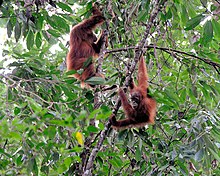
The social structure of the orangutan can be best described as solitary but social; they live a more solitary lifestyle than the other great apes.[45] Bornean orangutans are generally more solitary than Sumatran orangutans.[32] Most social bonds occur between adult females and their dependent and weaned offspring. Resident females live with their offspring in defined home ranges that overlap with those of other adult females, which may be their immediate relatives. One to several resident female home ranges are encompassed within the home range of a resident male, who is their main mating partner.[45][46] Interactions between adult females range from friendly to avoidance to antagonistic.[47] The home ranges of resident males can overlap greatly, though encounters are relatively rare and hostile.[48] Adult males are dominant over sub-adult males, the latter of which keep their distance.[49][48]
Orangutans disperse and establish their home ranges by age 11. Females tend to settle close to their mothers, while males disperse much farther but may include their natal (birth) range within their new home range.[46][50] They enter a transient phase, which lasts until a male can challenge and displace a dominant, resident male from his home range.[51] Both resident and transient orangutans aggregate on large fruiting trees to feed. The fruits tend to be abundant, so competition is low and individuals may engage in social interactions.[52][53][54] Orangutans will also form travelling groups with members moving between different food sources.[51] They are often consortships between an adult male and a female.[52] Social grooming is uncommon among orangutans.[55]
Orangutans communicate with various sounds. Males will make long calls, both to attract females and to advertise themselves to other males.[56] These are divided into three parts; they begin with grumbles, climax with pulses and end with bubbles. Both sexes will try to intimidate conspecifics with a series of low guttural noises known collectively as the "rolling call". When annoyed, an orangutan will suck in air through pursed lips, making a kissing sound known as the "kiss squeak". Mothers produce throatscrapes to keep in contact with their offspring. Infants make soft hoots when distressed. Orangutans are also known to produce smacks or blow raspberries when making a nest.[57]
Reproduction and development
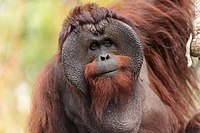
.jpg)
Males become sexually mature at around age 15. They may exhibit arrested development by not developing the distinctive cheek pads, pronounced throat pouches, long fur, or long calls until a resident dominant male is absent. The transformation from unflanged to flanged can occur quickly. Flanged males attract females in oestrous with their characteristic long calls, which may also suppress development in younger males.[56][16]:100
.jpg)
Unflanged males wander widely in search of oestrous females and upon finding one, will force copulation on her, the occurrence of which is unusually high among mammals. Females prefer to mate with the fitter flanged males and seek their company for protection. Non-ovulating females do not usually resist copulation with unflanged males, as the chance of conception is low. Resident males may form consortships that last for days, weeks or months after copulation.[58][49][51][59] Homosexual behaviour has been recorded in the context of both affiliative and aggressive interactions.[60]
Unlike females of other great apes species, orangutans do not exhibit sexual swellings to signal fertility.[59] The average age in which a female first gives birth is 15 years and they have a six to nine year interbirth interval, the longest among the great apes.[61] Gestation lasts around nine months and infants weigh 1.5–2 kg (3.3–4.4 lb) at birth.[16]:99 Usually only a single infant is born; twins are a rare occurrence.[62] Unlike many other primates, male orangutans do not seem to practice infanticide. This may be because they cannot ensure they will sire a female's next offspring, because she does not immediately begin ovulating again after her infant dies.[63] There is evidence that females with offspring under six years old generally avoid adult males.[64]
Females do most of the caring of the young, while males play no role. A female often has an older offspring with her to help socialise the infant.[55] Infant orangutans completely depend on their mothers for the first two years of their lives. The mother will carry the infant while travelling, and feed it and sleep with it in the same night nest.[16]:100 For the first four months, the infant is carried on its belly and almost never without physical contact. In the following months, the time an infant spends with its mother decreases. When an orangutan reaches the age of one-and-a-half years, its climbing skills improve and it will travel through the canopy holding hands with other orangutans, a behaviour known as "buddy travel".[55] After two years of age, juvenile orangutans will begin to move away from their mothers temporarily. They reach adolescence at six or seven years of age and will socialise with their peers while still having contact with their mothers.[16]:100 Females may nurse their offspring for up to eight years.[65] Typically, orangutans live over 30 years both in the wild and in captivity.[16]:14
Nesting
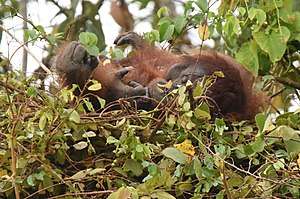
Orangutans build nests specialised for either day or night use. These are carefully constructed; young orangutans learn from observing their mother's nest-building behaviour. In fact, nest-building ability is a leading cause for young orangutans to regularly leave their mother. From six months of age onwards, orangutans practice nest-building and gain proficiency by the time they are three years old.[66]
Construction of a night nest is done by following a sequence of steps. Initially, a suitable tree is located. Orangutans are selective about sites, though many tree species are used. The nest is then built by pulling together branches under them and joining them at a point. After the foundation has been built, the orangutan bends smaller, leafy branches onto the foundation; this serves the purpose of and is termed the "mattress". After this, orangutans stand and braid the tips of branches into the mattress. Doing this increases the stability of the nest and is the final act of nest-building. Orangutans may add features, such as "pillows", "blankets", "roofs" and "bunk-beds" to their nests.[66]
Intelligence and cognition
Orangutans are among the most intelligent non-human primates. Experiments suggest they can track the displacement of objects both visible and hidden.[68][69] Zoo Atlanta has a touch-screen computer on which their two Sumatran orangutans play games.[70] A 2008 study of two orangutans at the Leipzig Zoo showed orangutans can use "calculated reciprocity", which involves weighing the costs and benefits of gift exchanges and keeping track of these over time. Orangutans are the first nonhuman species documented to do so.[71]
In a 1997 study, two captive adult orangutans were tested with the cooperative pulling paradigm. Without any training, the orangutans succeeded in pulling off an object to get food in the first session. Over the course of 30 sessions, the apes succeeded more quickly, having learned to coordinate.[72] An adult orangutan has been documented to pass the mirror test, indicating self-awareness.[73] Mirror tests with a 2-year-old orangutan failed to reveal self-recognition.[74]
Studies in the wild indicate that flanged male orangutans plan their movements in advance and signal them to other individuals.[75] Experiments have also suggested that orangutans can communicate about things that are not present, mother orangutans remain silent in the presence of a perceived threat but when it passes, the mother produces an alarm call to their offspring to teach them about the danger.[76] Orangutans and other great apes show laughter-like vocalisations in response to physical contact such as wrestling, play chasing or tickling. This suggests that laughter derived from a common origin among primate species and therefore evolved before the origin of humans.[77] Orangutans have also been found to have voluntary control over vocal fold oscillation, which is essential for speech in humans, and can learn and mimic new sounds.[67][78] Bonnie, an orangutan at the US National Zoo, was recorded spontaneously whistling after hearing a caretaker. She appears to whistle without expecting a food reward.[79]
Tool use and culture
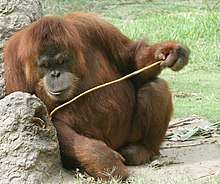
Tool use in orangutans was observed by primatologist Birutė Galdikas in ex-captive populations.[80] Orangutans in Suaq Balimbing were recorded to develop a tool kit for use in foraging which consisted of both insect-extraction sticks for use in the hollows of trees and seed-extraction sticks for harvesting seeds from hard-husked fruit. The orangutans adjusted their tools according to the task at hand, and preference was given to oral tool use.[81][82] This preference was also found in an experimental study of captive orangutans.[83] Orangutans have been observed to jab at catfish with sticks, so that the panicked prey would flop out of ponds and into the ape's waiting hands.[84][85] Orangutan have also been documented to save tools for future use.[86] When building a nest, orangutans appear to have some technical knowledge of construction and choose branches they know can support their body weight.[87]
Primatologist Carel P. van Schaik and biological anthropologist Cheryl D. Knott further investigated tool use in different wild orangutan populations. They compared geographic variations in tool use related to the processing of Neesia fruit. The orangutans of Suaq Balimbing were found to be avid users of insect and seed-extraction tools when compared to other wild orangutans.[88][89] The scientists suggested these differences are cultural as they do not correlate with habitat. The orangutans at Suaq Balimbing live in dense groups and are socially tolerant; this creates good conditions for social transmission.[88] Further evidence that highly social orangutans are more likely to exhibit cultural behaviours came from a study of leaf-carrying behaviours of formerly captive orangutans that were being rehabilitated on the island of Kaja in Borneo.[90]
Wild orangutans in Tuanan, Borneo, were reported to use tools in acoustic communication. They use leaves to amplify the kiss squeak sounds they produce. The apes may employ this method of amplification to deceive the listener into believing they are larger animals.[91] In 2003, researchers from six different orangutan field sites who used the same behavioural coding scheme compared the behaviours of the animals from each site. They found each orangutan population used different tools. The evidence suggested the differences were cultural: first, the extent of the differences increased with distance, suggesting cultural diffusion was occurring, and second, the size of the orangutans' cultural repertoire increased according to the amount of social contact present within the group. Social contact facilitates cultural transmission.[92]
Personhood
In June 2008, Spain became the first country in the world to recognise the rights of some non-human great apes, when its parliament's cross-party environmental committee urged the country to comply with the recommendations of the Great Ape Project, which are that chimpanzees, bonobos, orangutans, and gorillas are not to be used for animal experiments.[93][94] In December 2014, a court in Argentina ruled that an orangutan named Sandra at the Buenos Aires Zoo must be moved to a sanctuary in Brazil to provide her "partial or controlled freedom". Animal rights groups like Great Ape Project Argentina interpreted the ruling as applicable to all species in captivity, and legal specialists from the Argentina's Federal Chamber of Criminal Cassatio considered the ruling applicable only to non-human hominids.[95]
Orangutans and humans

Orangutans were known to the native people of Sumatra and Borneo for millennia. The apes are known as maias in Sarawak and mawas in other parts of Borneo and in Sumatra.[9] While some communities hunted them for food and decoration, others placed taboos on such practices. In central Borneo, some traditional folk beliefs consider it bad luck to look in the face of an orangutan. Some folk tales involve orangutans mating with and kidnapping humans. There are even stories of hunters being seduced by female orangutans.[16]:66–71
Europeans became aware of the existence of the orangutan in the 17th century.[16]:68 Explorers in Borneo hunted them extensively during the 19th century. The first scientific description of orangutans was given by Dutch anatomist Petrus Camper, who observed the animals and dissected some specimens.[16]:64–65 Camper mistakenly thought that flanged and unflanged male orangutans were different species, a misconception corrected after his death.[96]
Little was known about orangutan behaviour until the field studies of Birutė Galdikas,[97] who became a leading authority on the apes. When she arrived in Borneo in 1971, Galdikas settled into a primitive bark-and-thatch hut at a site she dubbed Camp Leakey, in Tanjung Puting. She studied orangutans for the next four years and developed her PhD thesis for UCLA.[98] Galdikas became an outspoken advocate for orangutans and the preservation of their rainforest habitat, which is rapidly being devastated by loggers, palm oil plantations, gold miners, and unnatural forest fires.[99] Along with Jane Goodall and Dian Fossey, Galdikas is considered to be one of Leakey's Angels, named after anthropologist Louis Leakey.[100]
In fiction
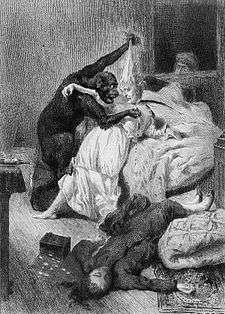
Orangutans first appeared in Western fiction in the 18th century and have been used to comment on human society. Written by the pseudonymous A. Ardra, Tintinnabulum naturae (The Bell of Nature, 1772) is told from the point of view of a human-orangutan hybrid who calls himself the "metaphysician of the woods". Over half a century later, the anonymously written work The Orang Outang is narrated by a pure orangutan in captivity in the US, writing to her friend in Java and critiquing Boston society.[5]:108–109
Thomas Love Peacock's 1817 novel Melincourt features Sir Oran Hautto, an orangutan who participates in English society and becomes a candidate for Parliament. The novel satirises the class and political system of Britain. Oran's reliability, honesty and status as a "natural man" stand in contrast to the cowardice, greed, folly, and inequality of "civilised" human society.[5]:110–111 In Frank Challice Constable's The Curse of Intellect (1895), the protagonist Reuben Power travels to Borneo to capture and train an orangutan "to know what a beast like that might think of us".[5]:114–115 Orangutans are featured prominently in the 1963 science fiction novel Planet of the Apes by Pierre Boulle and the media franchise derived from it. Orangutans are typically portrayed as bureaucrats like Dr. Zaius, the science minister.[5]:118–119, 175–176
Orangutans are sometimes portrayed as villains, notably in the 1832 Walter Scott novel Count Robert of Paris and the 1841 Edgar Allan Poe short story The Murders in the Rue Morgue where the ape was trained to murder by his human master.[5]:145 Disney's 1967 animated musical adaptation of The Jungle Book added an orangutan named King Louie, voiced by Louis Prima, who tries to get Mowgli to teach him how to make fire.[5]:266 The 1986 horror film Link features an intelligent orangutan which serves a university professor but has sinister motives, particularly with his stalking of a student assistant.[5]:174–175 Some stories have portrayed orangutans as guides to humans, such as The Librarian in Terry Pratchett's fantasy novels Discworld and in Dale Smith's 2004 novel What the Orangutan Told Alice.[5]:145 More comical portrayals of the orangutan include the 1996 film Dunston Checks In.[5]:181
In captivity
By the early 19th century, orangutans were being kept in captivity. In 1817, an orangutan joined several other animals in London's Exeter Exchange. The ape was recorded to have shunned the company of other animals, aside from a dog, and appeared to prefer the company of humans. It was occasionally taken on coach rides dressed in a smock-frock and hat and even treated with refreshments at an inn where it impressed its host with its polite behaviour.[5]:64–65 The London Zoo housed a female orangutan named Jenny who was dressed in human clothing and learned to drink tea. She is remembered for her meeting with Charles Darwin who compared her reactions to those of a human child.[101][102]
Zoos and circuses in the Western world would continue to use orangutans and other simians as sources for entertainment, training them to behave like humans at tea parties and to perform tricks. Notable orangutan "character actors" include Jacob and Rosa of the Tierpark Hagenbeck in the early 20th century and Jiggs of the San Diego Zoo in the 1930s and 1940s.[5]:187–189, 193–194 Animal rights groups have urged a stop to such acts, considering them abusive.[103] Starting in the 1960s, zoos became more concerned with education and orangutans exhibits were designed to mimic their natural environment and displayed their natural behaviours.[5]:185, 206
Ken Allen, an orangutan of the San Diego Zoo, became world famous in the 1980s for multiple escapes from his enclosures. He was nicknamed "the hairy Houdini" and was the subject of a fan club, T-shirts, bumper stickers and a song titled The Ballad of Ken Allen.[104] Galdikas reported that her cook was sexually assaulted by a captive male orangutan.[105] The ape may have suffered from a skewed species identity and forced copulation is a standard mating strategy for low-ranking male orangutans.[106]
Conservation
Status and threats
All three species are critically endangered according to the IUCN Red List of mammals.[107][108][109] They are legally protected from capture, harm or killing in both Malaysia and Indonesia,[110] and are listed under Appendix I by CITES, which prohibits their unlicensed trade under international law.[111] The Bornean orangutan range has become patchy, being largely extirpated from several parts of the island, including the southeast.[108] The largest remaining population is found in the forest around the Sabangau River, but this environment is at risk.[112] The Sumatran orangutan is found only in the northern part of Sumatra, most of the population inhabiting the Leuser Ecosystem.[107] The Tapanuli orangutan is found only in the Batang Toru forest of Sumatra.[109]
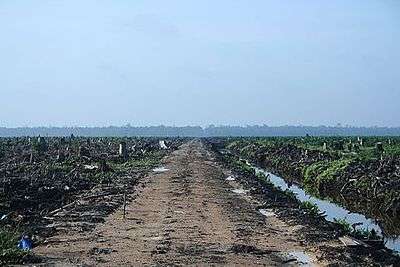
During the early 2000s, orangutan habitats decreased rapidly because of logging and forest fires, and fragmentation by roads. A major factor has been the conversion of vast areas of tropical forest to palm oil plantations in response to international demand. Hunting is also a major problem, as is the illegal pet trade.[107][108] Orangutans may be killed for the bushmeat trade[113] and bones are secretly traded in souvenir shops in several cities in Indonesian Borneo.[114] Conflicts between locals and orangutans also pose a threat. Orangutans that have lost their homes often raid agricultural areas and end up being killed by villagers.[115] Locals may also be motivated to kill orangutans for food or because of fear and self-defense.[116] Mother orangutans are killed so their infants can be sold as pets, and many of these infants die without the help of their mother. Since 2012, the Indonesian authorities, with the aid of the Orangutan Information Center, confiscated 114 orangutans, 39 of which were pets.[117]
Estimates between 2000 and 2003 found 7,300 Sumatran orangutans[107] and between 45,000 and 69,000 Bornean orangutans[108] remain in the wild.[118] A 2016 study estimates a population of 14,613 Sumatran orangutans in the wild, doubling previous population estimates.[119] Fewer than 800 Tapanuli orangutan are estimated to still exist, which puts the species among the most endangered of the great apes.[120][39] The table below shows a breakdown of the species and subspecies and their estimated populations from this or (in the case of P. tapanuliensis) a 2017 report:[118][121][119]
| Scientific name |
Common name |
Region | Estimated number |
|---|---|---|---|
| Pongo abelii | Sumatran orangutan | Sumatra | 14,613 |
| Pongo tapanuliensis | Tapanuli orangutan | Sumatra (Lake Toba region) | <800 |
| Pongo pygmaeus | Bornean orangutan | Borneo | |
| P. p. morio | Northeast Bornean orangutan | Sabah (Malaysia) | 11,017 |
| East Kalimantan | 4,825 | ||
| P. p. wurmbii | Central Bornean orangutan | Central Kalimantan | >34,975 |
| P. p. pygmaeus | Northwest Bornean orangutan | West Kalimantan | 2,000–2,500 |
| Sarawak (Malaysia) | 1,143–1,761 |
Conservation centres and organisations
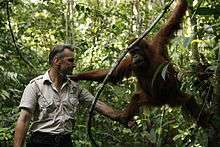
Several organisations are working for the rescue, rehabilitation and reintroduction of orangutans. The largest of these is the Borneo Orangutan Survival (BOS) Foundation, founded by conservationist Willie Smits and which operates projects such as the Nyaru Menteng Rehabilitation Program founded by conservationist Lone Drøscher Nielsen.[122][123][124] A female orangutan was rescued from a village brothel in Kareng Pangi village, Central Kalimantan, in 2003. The orangutan was shaved and chained for sexual purposes. Since being freed, the orangutan, named Pony, has been living with the BOS. She has been re-socialised to live with other orangutans.[125] In May 2017, the BOS rescued an albino orangutan from captivity. The rare primate was being held captive in a remote village in Kapuas Hulu, on the island of Kalimantan in Indonesian Borneo. According to volunteers at BOS, albino orangutans are extremely rare (one in ten thousand). This is the first albino orangutan the organisation has seen in 25 years of activity.[126]
Other major conservation centres in Indonesia include those at Tanjung Puting National Park, Sebangau National Park, Gunung Palung National Park and Bukit Baka Bukit Raya National Park in Borneo and the Gunung Leuser National Park and Bukit Lawang in Sumatra. In Malaysia, conservation areas include Semenggoh Wildlife Centre and Matang Wildlife Centre also in Sarawak, and the Sepilok Orang Utan Sanctuary in Sabah.[127] Major conservation centres headquartered outside the orangutans' home countries include Frankfurt Zoological Society,[128] Orangutan Foundation International, which was founded by Galdikas,[129] and the Australian Orangutan Project.[130] Conservation organisations such as the Orangutan Land Trust work with the palm oil industry to improve sustainability and encourages the industry to establish conservation areas for orangutans.[131][132]
References
- "Orangutan". Lexico. Oxford University Press. Retrieved 23 December 2014.
- Harper, Douglas. "Orangutan". Online Etymology Dictionary. Retrieved 4 May 2012.
- Mahdi, Waruno (2007). Malay Words and Malay Things: Lexical Souvenirs from an Exotic Archipelago in German Publications Before 1700. Frankfurter Forschungen zu Südostasien. 3. Otto Harrassowitz Verlag. pp. 170–181. ISBN 978-3-447-05492-8.
- Dellios, Paulette (2008). "A lexical odyssey from the Malay World". Studia Universitatis Petru Maior. Philologia. 4 (4): 141–144.
- Cribb, Robert; Gilbert, Helen; Tiffin, Helen (2014). Wild Man from Borneo: A Cultural History of the Orangutan. University of Hawai'i Press. ISBN 978-0-8248-3714-3.
- "Orangutan". Alpha Dictionary. Retrieved 20 December 2006.
- Tan, Peter (October 1998). "Malay loan words across different dialects of English". English Today. 14 (4): 44–50. doi:10.1017/S026607840001052X.
- Cannon, Garland (1992). "Malay(sian) borrowings in English". American Speech . 67 (2): 134–162. doi:10.2307/455451. JSTOR 455451.
- Rubis, June Mary (2020). "The orang utan is not an indigenous name: knowing and naming the maias as a decolonizing epistemology". Cultural Studies. doi:10.1080/09502386.2020.1780281.
- Groves, Colin P. (2002). "A history of gorilla taxonomy" (PDF). In Taylor, Andrea B.; Goldsmith, Michele L. (eds.). Gorilla Biology: A Multidisciplinary Perspective. Cambridge University Press. pp. 15–34. doi:10.1017/CBO9780511542558.004. Archived from the original (PDF) on 26 March 2009.
- "pongo". Etymology Online. Retrieved 4 December 2018.
- "pongo". Merriam-Webster. Retrieved 4 October 2018.
- "pongo, n.1". OED Online. Oxford University Press. Retrieved 4 October 2018.
- Lesson, René-Primevère (1827). Manuel de mammalogie ou Histoire naturelle des mammifères (in French). Roret, Libraire. p. 32.
- Xu, X.; Arnason, U. (1996). "The mitochondrial DNA molecule of sumatran orangutan and a molecular proposal for two (Bornean and Sumatran) species of orangutan". Journal of Molecular Evolution. 43 (5): 431–437. Bibcode:1996JMolE..43..431X. doi:10.1007/BF02337514. PMID 8875856.
- Payne, J; Prundente, C (2008). Orangutans: Behavior, Ecology and Conservation. New Holland Publishers. ISBN 978-0-262-16253-1.
- Nater, A.; Mattle-Greminger, M. P.; Nurcahyo, A.; Nowak, M. G.; et al. (2 November 2017). "Morphometric, Behavioral, and Genomic Evidence for a New Orangutan Species". Current Biology. 27 (22): 3487–3498.e10. doi:10.1016/j.cub.2017.09.047. PMID 29103940.
- Bradon-Jones, D.; Eudey, A. A.; Geissmann, T.; Groves, C. P.; Melnick, D. J.; Morales, J. C.; Shekelle, M.; Stewart, C. B. (2004). "Asian primate classification" (PDF). International Journal of Primatology. 25: 97–164. doi:10.1023/B:IJOP.0000014647.18720.32.
- Locke, D. P.; Hillier, L. W.; Warren, W. C.; Worley, K. C.; Nazareth, L. V.; Muzny, D. M.; Yang, S. P.; Wang, Z.; Chinwalla, A. T.; Minx, P.; Mitreva, M.; Cook, L.; Delehaunty, K. D.; Fronick, C.; Schmidt, H.; Fulton, L. A.; Fulton, R. S.; Nelson, J. O.; Magrini, V.; Pohl, C.; Graves, T. A.; Markovic, C.; Cree, A.; Dinh, H. H.; Hume, J.; Kovar, C. L.; Fowler, G. R.; Lunter, G.; Meader, S.; et al. (2011). "Comparative and demographic analysis of orang-utan genomes". Nature. 469 (7331): 529–533. Bibcode:2011Natur.469..529L. doi:10.1038/nature09687. PMC 3060778. PMID 21270892.
- Singh, Ranjeet (26 January 2011). "Orang-utans join the genome gang". Nature. doi:10.1038/news.2011.50. Retrieved 27 January 2011.
- Rijksen H. D.; Meijaard, E. (1999). Our vanishing relative: the status of wild orang-utans at the close of the twentieth century. Springer. ISBN 978-0792357551.
- Israfil, H.; Zehr, S. M.; Mootnick, A. R.; Ruvolo, M.; Steiper, M. E. (2011). "Unresolved molecular phylogenies of gibbons and siamangs (Family: Hylobatidae) based on mitochondrial, Y-linked, and X-linked loci indicate a rapid Miocene radiation or sudden vicariance event" (PDF). Molecular Phylogenetics and Evolution. 58 (3): 447–455. doi:10.1016/j.ympev.2010.11.005. PMC 3046308. PMID 21074627. Archived from the original (PDF) on 10 May 2012.
- Goldman, Jason G. (2 November 2017). "New Species of Orangutan Is Rarest Great Ape on Earth". National Geographic Society. Retrieved 6 November 2017.
- Groves, C. P. (2005). Wilson, D. E.; Reeder, D. M. (eds.). Mammal Species of the World: A Taxonomic and Geographic Reference (3rd ed.). Baltimore: Johns Hopkins University Press. pp. 183–184. ISBN 0-801-88221-4. OCLC 62265494.
- Bhandari, A.; Kay, R. F.; Williams, B. A.; Tiwari, B. N.; Bajpai, S.; Heironymus, T. (2018). "First record of the Miocene hominoid Sivapithecus from Kutch, Gujarat state, western India". PLoS One. 13 (11): 10.1371/journal.pone.0206314. doi:10.1371/journal.pone.0206314. PMC 6235281. PMID 30427876.
- Zhang, Yingqi; Harrison, Terry (2017). "Gigantopithecus blacki: a giant ape from the Pleistocene of Asia revisited". Supplement: Yearbook of Physical Anthropology. 162 (S63): 153–177. doi:10.1002/ajpa.23150.
- Harrison, Terry; Jin, Changzhu; Zhang, Yingqi; Wang, Yuan; Zhu, Min (December 2014). "Fossil Pongo from the Early Pleistocene Gigantopithecus fauna of Chongzuo, Guangxi, southern China". Quaternary International. 354: 59–67. doi:10.1016/j.quaint.2014.01.013.
- Wang, Cui-Bin; Zhao, Ling-Xia; Jin, Chang-Zhu; Wang, Yuan; Qin, Da-Gong; Pan, Wen-Shi (December 2014). "New discovery of Early Pleistocene orangutan fossils from Sanhe Cave in Chongzuo, Guangxi, southern China". Quaternary International. 354: 68–74. doi:10.1016/j.quaint.2014.06.020.
- Schwartz, J. H.; Vu The Long; Nguyen Lan Cuong; Le Trung Kha; Tattersall, I. (1995). "A review of the Pleistocene hominoid fauna of the Socialist Republic of Vietnam (excluding Hylobatidae)". Anthropological Papers of the American Museum of Natural History (76): 1–24. hdl:2246/259.
- Ibrahim, Yasamin Kh.; Tshen, Lim Tze; Westaway, Kira E.; Cranbrook, Earl of; Humphrey, Louise; Muhammad, Ros Fatihah; Zhao, Jian-xin; Peng, Lee Chai (December 2013). "First discovery of Pleistocene orangutan (Pongo sp.) fossils in Peninsular Malaysia: Biogeographic and paleoenvironmental implications". Journal of Human Evolution. 65 (6): 770–797. doi:10.1016/j.jhevol.2013.09.005. PMID 24210657.
- Groves, Colin P. (1971). "Pongo pygmaeus". Mammalian Species. 4 (4): 1–6. doi:10.2307/3503852. JSTOR 3503852.
- van Schaik, C.; MacKinnon, J. (2001). "Orangutans". In MacDonald, D. (ed.). The Encyclopedia of Mammals (2nd ed.). Oxford University Press. pp. 420–23. ISBN 978-0-87196-871-5.
- Aiello, L.; Dean, C. (1990). An Introduction to Human Evolutionary Anatomy. Academic Press. p. 193. ISBN 0-12-045590-0.
- Hilloowala, R. A.; Trent, R. B. (1988). "Supraorbital ridge and masticatory apparatus I: Primates". Human Evolution. 3: 343–350. doi:10.1007/BF02447216.
- Winkler, L. A. (1989). "Morphology and relationships of the orangutan fatty cheek pads". American Journal of Primatology. 17 (4): 305–19. doi:10.1002/ajp.1350170405. PMID 31964053.
- Rose, M. D. (1988). "Functional Anatomy of the Cheirdia". In Schwartz, Jeffrey (ed.). Orang-utan Biology. Oxford University Press. p. 301. ISBN 978-0-19-504371-6.
- Oishi, M.; Ogihara, N.; Endo, H.; Ichihara, N.; Asari, M. (2009). "Dimensions of forelimb muscles in orangutans and chimpanzees". Journal of Anatomy. 215 (4): 373–382. doi:10.1111/j.1469-7580.2009.01125.x.
- Schwartz, Jeffrey (1987). The Red Ape: Orangutans and Human Origins. Westview Press. pp. 6–7. ISBN 978-0-8133-4064-7.
- Reese, April (2 November 2017). "Newly discovered orangutan species is also the most endangered". Nature. 551 (7679): 151. doi:10.1038/nature.2017.22934. PMID 29120449.
- Galdikas, Birute M. F. (1988). "Orangutan Diet, Range, and Activity at Tanjung Puting, Central Borneo". International Journal of Primatology. 9 (1): 1–35. doi:10.1007/BF02740195.
- Rodman, P. S. (1988). "Diversity and consistency in ecology and behavior". In Schwartz, J. H. (ed.). Orang-utan biology. Oxford University Press. pp. 31–51. ISBN 9780195043716.
- Foitová, Ivona; Huffman, Michael A.; Wisnu, Nurcahyo; Olšanský, Milan (2009). "Parasites and their impacts on orangutan health". In Wich, Serge A.; Atmoko, S. Suci Utami; Setia, Tatang Mitra; van Schaik, Carel P. (eds.). Orangutans: Geographic Variation in Behavioral Ecology and Conservation. Oxford University Press. p. 166. ISBN 978-0199213276.
- Morrogh-Bernard HC, Foitová I, Yeen Z, Wilkin P, de Martin R, Rárová L, Doležal K, Nurcahyo W, Olšanský M (2017). "Self-medication by orang-utans (Pongo pygmaeus) using bioactive properties of Dracaena cantleyi". Scientific Reports. 7 (16653). doi:10.1038/s41598-017-16621-w.
- Rijksen, H. D. (December 1978). "A field study on Sumatran orang utans (Pongo pygmaeus abelii, Lesson 1827): Ecology, Behaviour and Conservation". The Quarterly Review of Biology. 53 (4): 493–494. doi:10.1086/410942. JSTOR 2826733.
- Teboekhorst, I.; Schürmann, C.; Sugardjito, J. (1990). "Residential status and seasonal movements of wild orang-utans in the Gunung Leuser Reserve (Sumatera, Indonesia)". Animal Behaviour. 39 (6): 1098–1109. doi:10.1016/S0003-3472(05)80782-1.
- Singleton, I.; van Schaik, C. P. (2002). "The Social Organisation of a population of Sumatran orang-utans". Folia Primatologica. 73 (1): 1–20. doi:10.1159/000060415. PMID 12065937.
- Galdikas, B. M. F. (1984). "Adult female sociality among wild orangutans at Tanjung Puting Reserve". In Small, M. F. (ed.). Female Primates: Studies by Women Primatologists. Alan R. Liss. pp. 217–35. ISBN 978-0845134030.
- Atmoko, S. Suci Utami; Singleton, Ian; van Noordwijk, Maria A.; van Schaik, Carel P.; Setia, Tatang Mitra (2009). "Male–male relationships in orangutans". In Wich, Serge A.; Atmoko, S. Suci Utami; Setia, Tatang Mitra; van Schaik, Carel P. (eds.). Orangutans: Geographic Variation in Behavioral Ecology and Conservation. Oxford University Press. pp. 227–228. ISBN 978-0-19-921327-6.
- Fox, E. A. (2002). "Female tactics to reduce sexual harassment in the Sumatran orangutan (Pongo pygmaeus abelii)". Behavioral Ecology and Sociobiology. 52 (2): 93–101. doi:10.1007/s00265-002-0495-x.
- van Noordwijk, Maria A.; Sauren, Simone E.B.; Nuzuar; Abulani, Ahbam; Morrogh-Bernard, Helen C.; Atmoko, S. Suci Utami; van Schaik, Carel P. (2009). "Development of Independence". In Wich, Serge A.; Atmoko, S. Suci Utami; Setia, Tatang Mitra; van Schaik, Carel P. (eds.). Orangutans: Geographic Variation in Behavioral Ecology and Conservation. Oxford University Press. p. 199. ISBN 978-0199213276.
- Delgado, R. A. Jr.; van Schaik, C. P. (2000). "The behavioral ecology and conservation of the orangutan (Pongo pygmaeus): a tale of two islands". Evolutionary Anthropology: Issues, News, and Reviews. 9 (1): 201–18. doi:10.1002/1520-6505(2000)9:5<201::AID-EVAN2>3.0.CO;2-Y.
- van Schaik, C. P.; Preuschoft, S.; Watts, D. P. (2004). "Great ape social systems". In Russon, A. E.; Begun, D. R. (eds.). The Evolution of Thought: Evolutionary Origins of Great Ape Intelligence. Cambridge University Press. pp. 193–194. ISBN 978-0521039925.
- van Schaik, C. P. (1999). "The socioecology of fission-fusion sociality in orangutans". Primates. 40 (1): 69–86. doi:10.1007/BF02557703. PMID 23179533.
- Mitani, J. C.; Grether, G. F.; Rodman, P. S.; Priatna, D. (1991). "Associations among wild orang-utans: sociality, passive aggregations or chance". Animal Behaviour. 42 (1): 33–46. doi:10.1016/S0003-3472(05)80603-7.
- Munn, C.; Fernandez, M. (1997). "Infant development". In Carol Sodaro (ed.). Orangutan Species Survival Plan Husbandry Manual. Chicago Zoological Park. pp. 59–66. OCLC 40349739.
- Utami, S. S.; Goossens, B.; Bruford, M. W.; de Ruiter, J. R.; van Hooff, J. A. R. A. M. (2002). "Male bimaturism and reproductive success in Sumatran orangutans". Behavioral Ecology. 13 (5): 643–52. doi:10.1093/beheco/13.5.643.
- "Orangutan call repertoires". Universität Zürich – Department of Anthropology. Retrieved 23 April 2020.
- Schürmann, C. L.; van Hooff, J. A. R. A. M. (1986). "Reproductive strategies of the orangutan: new data and a reconsideration of existing sociosexual models". International Journal of Primatology. 7 (3): 265–87. doi:10.1007/BF02736392.
- Knott, Cheryl Denise; Thompson, Melissa Emery; Stumpf, Rebecca M; McIntyre, Matthew H (2009). "Female reproductive strategies in orangutans, evidence for female choice and counterstrategies to infanticide in a species with frequent sexual coercion". Proceedings of the Royal Society B: Biological Sciences. 277 (1678). doi:10.1098/rspb.2009.1552.
- Fox, Elizabeth A (2001). "Homosexual behavior in wild Sumatran orangutans (Pongo pygmaeus abelii)". American Journal of Primatology. 55 (3): 177–181. doi:10.1002/ajp.1051.
- Wich, Serge A.; de Vries, Hans; Ancrenaz, Marc; Perkins, Lori; Shumaker, Robert W.; Suzuki, Akira; van Schaik, Carel P. (2009). "Orangutan life history variation". In Wich, Serge A.; Atmoko, S. Suci Utami; Setia, Tatang Mitra; van Schaik, Carel P. (eds.). Orangutans: Geographic Variation in Behavioral Ecology and Conservation. Oxford University Press. pp. 67–68. ISBN 978-0199213276.
- Goossens, B; Mohd, D; Kapar; Kahar, S (2011). "First Sighting of Bornean Orangutan Twins in the Wild". Asian Primates Journal. 2 (1): 10–12.
- Beaudrot, LH; Kahlenberg, SM; Marshall, AJ (2009). "Why male orangutans do not kill infants". Behavioral Ecology and Sociobiology. 63 (11): 1549–1562. doi:10.1007/s00265-009-0827-1. PMC 2728907. PMID 19701484.
- Scott, A. M.; Knott, C. D.; Susanto, T. W. (2019). "Are Male Orangutans a Threat to Infants? Evidence of Mother–Offspring Counterstrategies to Infanticide in Bornean Orangutans (Pongo pygmaeus wurmbii)". International Journal of Primatology. 44 (3): 435–455. doi:10.1007/s10764-019-00097-8.
- Smith, Tanya M.; Austin, Christine; Hinde, Katie; Vogel, Erin R.; Arora, Manish (2017). "Cyclical nursing patterns in wild orangutans". Evolutionary Biology. 3 (5): e1601517. doi:10.1126/sciadv.1601517.
- Didik, Prasetyo; Ancrenaz, Marc; Morrogh-Bernard, Helen C.; Atmoko, S. Suci Utami; Wich, Serge A.; van Schaik, Carel P. (2009). "Nest building in orangutans". In Wich, Serge A.; Atmoko, S. Suci Utami; Setia, Tatang Mitra; van Schaik, Carel P. (eds.). Orangutans: Geographic Variation in Behavioral Ecology and Conservation. Oxford University Press. pp. 270–275. ISBN 978-0-19-921327-6.
- Lameira, A. R.; Hardus, M. E.; Shumaker, R. W.; Wich, S. A.; Menken, S. B. J. (2015). "Speech-Like Rhythm in a Voiced and Voiceless Orangutan Call". PLoS ONE. 10 (1): e116136. doi:10.1371/journal.pone.0116136.
- Deaner, R. O.; van Schaik, C. P.; Johnson, V. (2006). "Do some taxa have better domain-general cognition than others? A meta-analysis of nonhuman primate studies". Evolutionary Psychology. 4: 149–196.
- de Blois, S. T.; Novak, M. A.; Bond, M. (1998). "Object Permanence in Orangutans (Pongo Pygmaeus) and Squirrel Monkeys (Saimiri Sciureus)". Journal of Comparative Psychology. 112 (2): 137–152. doi:10.1037/0735-7036.112.2.137. PMID 9642783.
- Turner, Dorie (12 April 2007). "Orangutans play video games (for research) at Georgia zoo". USA Today. Retrieved 12 April 2007.
- Dufour, V.; Pelé, M.; Neumann, M.; Thierry, B.; Call, J. (2008). "Calculated reciprocity after all: computation behind token transfers in orang-utans". Biology Letters. 5 (2): 172–75. doi:10.1098/rsbl.2008.0644. PMC 2665816. PMID 19126529.
- Chalmeau, Raphaël; Lardeux, Karine; Brandibas, Pierre; Gallo, Alain (1997). "Cooperative problem solving by orangutans (Pongo pygmaeus)". International Journal of Primatology. 18 (1): 23–32. doi:10.1023/A:1026337006136.
- Suárez, S. D.; Gallup, G. G. (1981). "Self-recognition in chimpanzees and orangutans, but not gorillas". Journal of Human Evolution. 10 (2): 175–188. doi:10.1016/s0047-2484(81)80016-4.
- Robert, S. (1986). "Ontogeny of mirror behavior in two species of great apes". American Journal of Primatology. 10 (2): 109–117. doi:10.1002/ajp.1350100202. PMID 31979488.
- van Schaik, Carel P.; Damerius, L.; Isler, K. (2013). "Wild Orangutan Males Plan and Communicate Their Travel Direction One Day in Advance". PLoS One. 8 (9): e74896. doi:10.1371/journal.pone.0074896.
- Lameira, Adriano R.; Call, Josep (2018). "Time-space–displaced responses in the orangutan vocal system". Science Advances. 4 (11): eaau3401. doi:10.1126/sciadv.aau3401.
- Ross, Marina Davila; Owren, Michael J; Zimmermann, Elke (2009). "Reconstructing the Evolution of Laughter in Great Apes and Humans". Current Biology. 19 (13): 1106–1111. doi:10.1016/j.cub.2009.05.028. PMID 19500987.
- Lameira, A. R.; Shumaker, R. W. (2019). "Orangutans show active voicing through a membranophone". Scientific Reports. 9: 12289. doi:10.1038/s41598-019-48760-7.
- Wich, S. A.; Swartz, K. B.; Hardus, M. E.; Lameira, A. R.; Stromberg, E.; Shumaker, R. W. (2008). "A case of spontaneous acquisition of a human sound by an orangutan". Primates. 50 (1): 56–64. doi:10.1007/s10329-008-0117-y. PMID 19052691.
- Galdikas, B. M. F. (1982). "Orang-Utan tool use at Tanjung Putting Reserve, Central Indonesian Borneo (Kalimantan Tengah)". Journal of Human Evolution. 10: 19–33. doi:10.1016/S0047-2484(82)80028-6.
- Fox, E. A.; Sitompul, A. F.; van Schaik, C. P. (1999). "Intelligent tool use in wild Sumatran orangutans". In Parker, S; Mitchell, R. W.; Miles, H. L. (eds.). The Mentality of Gorillas and Orangutans. Cambridge University Press. pp. 99–116. ISBN 978-0-521-03193-6.
- van Schaik, C. P.; Fox, E. A.; Sitompul, A. F. (1996). "Manufacture and use of tools in wild Sumatran orangutans – implications or human evolution". Naturwissenschaften. 83 (4): 186–188. Bibcode:1996NW.....83..186V. doi:10.1007/BF01143062. PMID 8643126.
- O'Malley, R. C.; McGrew, W. C. (2000). "Oral tool use by captive orangutans (Pongo pygmaeus)". Folia Primatologica. 71 (5): 334–341. doi:10.1159/000021756. PMID 11093037.
- Russon, A. E.; Compost, A.; Kuncoro, P.; Ferisa, A. (2014). "Orangutan Fish Eating, Primate Aquatic Fauna Eating, and Their Implications for the Origins of Ancestral Hominin Fish Eating". Journal of Human Evolution. 77: 50–63. doi:10.1016/j.jhevol.2014.06.007. PMID 25038033.
- Bower, B. (18 April 2011). "Orangutans use simple tools to catch fish". Wired. Retrieved 5 August 2013.
- Mulcahy, N. J. (2018). "An Orangutan Hangs Up a Tool for Future Use". Scientific Reports. 8 (1): 1–6. doi:10.1038/s41598-018-31331-7.
- van Casteren, A.; Sellers, W. I.; Thorpe, S. K. S.; Coward, S.; Crompton, R. H.; Myatt, J. P.; Ennos, A. R. (2012). "Nest-building orangutans demonstrate engineering know-how to produce safe, comfortable beds". PNAS. 109 (18): 6873–6877. doi:10.1073/pnas.1200902109.
- van Schaik, Carel P.; Knott, Cheryl D. (2001). "Geographic variation in tool use onNeesia fruits in orangutans". American Journal of Physical Anthropology. 114 (4): 331–342. doi:10.1002/ajpa.1045. PMID 11275962.
- van Schaik, CP; Van Noordwijk, MA; Wich, SA. (2006). "Innovation in wild Bornean orangutans (Pongo pygmaeus wurmbii)". Behaviour. 143 (7): 839–876. doi:10.1163/156853906778017944.
- Russon, AE; Handayani, DP; Kuncoro, P; Ferisa, A. (2007). "Orangutan leaf-carrying for nest-building: toward unraveling cultural processes". Animal Cognition. 10 (2): 189–202. doi:10.1007/s10071-006-0058-z. PMID 17160669.
- Hardus, M. E.; Lameira, A. R.; van Schaik, C. P.; Wich, S. A. (2009). "Tool use in wild orang-utans modifies sound production: a functionally deceptive innovation?". Proceedings of the Royal Society B. 276 (1673): 3689–3694. doi:10.1098/rspb.2009.1027. PMC 2817314. PMID 19656794.
- van Schaik, C. P.; Ancrenaz, M.; Borgen, G.; Galdikas, B.; Knott, C. D.; Singleton, I.; Suzuki, A.; Utami, S. S.; Merrill, M.; et al. (2003). "Orangutan cultures and the evolution of material culture". Science. 299 (5603): 102–105. Bibcode:2003Sci...299..102V. doi:10.1126/science.1078004. PMID 12511649.
- Glendinning, L. (26 June 2008). "Spanish parliament approves 'human rights' for apes". The Guardian. Retrieved 10 November 2008.
- Singer, P. (18 July 2008). "Of great apes and men". The Guardian. Retrieved 10 November 2008.
- Giménez, Emiliano (23 December 2014). "Argentine orangutan granted unprecedented legal rights". CNN. Retrieved 15 June 2020.
- Meijer, Miriam Claude (2014). Race and Aesthetics in the Anthropology of Petrus Camper (1722-1789) (Studies in the History of Ideas in the Low Countries). Rodopi. p. 42. ISBN 978-9042004344.
- de Waal, Frans (January 1995). "The Loneliest of Apes". The New York Times. Retrieved 26 February 2012.
- Oaks, Elizabeth H. (2007). Encyclopedia of World Scientists: From Around the World. Facts on File. p. 260. ISBN 978-0816041305.
- McDowell, Robin (18 January 2009). "Palm oil frenzy threatens to wipe out orangutans". Associated Press. Archived from the original on 20 January 2009. Retrieved 18 January 2009.
- MacClancy, J.; Fuentes, A. (2010). Centralizing Fieldwork: Critical Perspectives from Primatology, Biological, and Social Anthropology. Berghahn Books. pp. 6–7. ISBN 978-1-84545-690-0.
- van Wyhe, John; Kjærgaard, Peter C. (1 June 2015). "Going the whole orang: Darwin, Wallace and the natural history of orangutans". Studies in History and Philosophy of Science Part C: Studies in History and Philosophy of Biological and Biomedical Sciences. 51: 53–63. doi:10.1016/j.shpsc.2015.02.006. ISSN 1369-8486. PMID 25861859.
- Zimmer, Carl (21 April 2015). "When Darwin Met Another Ape". National Geographic Society. Retrieved 24 February 2020.
- "Animal Actors". PETA. Archived from the original on 3 March 2010. Retrieved 28 January 2011.
- Middleton, Duncan (7 August 2016). "The missing lynx and five other animal escapees including Ken Allen the Orangutan". BBC Newsbeat. Retrieved 25 December 2018.
- Wrangham, Richard W; Peterson, Dale (1996). Demonic Males: Apes and the Origins of Human Violence. Houghton Mifflin. p. 137. ISBN 978-0-395-69001-7.
- van Schaik, Carel (2004). Among Orangutans: Red Apes and the Rise of Human Culture. Harvard University Press. p. 88.
- Singleton, I.; Wich, S. A.; Griffiths, M. (2008). "Pongo abelii". IUCN Red List of Threatened Species. 2008. Retrieved 28 January 2011.
- Ancrenaz, M.; Gumal, M.; Marshall, A. J.; Meijaard, E.; Wich, S. A.; Husson, S. (2016). "Pongo pygmaeus". IUCN Red List of Threatened Species. 2016: e.T17975A17966347. doi:10.2305/IUCN.UK.2016-1.RLTS.T17975A17966347.en.
- Nowak, Matthew G.; Rianti, Puji; Wich, Serge A.; Meijaard, Erik; Fredriksson, Gabriella (2017). "Pongo tapanuliensis". IUCN Red List of Threatened Species. 2017.3. 2017: e.T120588639A120588662. doi:10.2305/IUCN.UK.2017-3.RLTS.T120588639A120588662.en.
- Neme, Laurel (11 October 2014). "Endangered Orangutans Gain From Eco-Friendly Shifts in Palm Oil Market". National Geographic Society. Retrieved 1 July 2020.
- "On the edge of extinction". Sumatran Orangutan Society. Retrieved 1 July 2020.
- Cheyne, S. M.; Thompson, C. J.; Phillips, A. C.; Hill, R. M.; Limin, S. H. (2007). "Density and population estimate of gibbons (Hylobates albibarbis) in the Sabangau catchment, Central Kalimantan, Indonesia". Primates. 49 (1): 50–56. doi:10.1007/s10329-007-0063-0. PMID 17899314.
- Than, Ker (16 November 2011). "Hundreds of Orangutans Killed Annually for Meat". National Geographic Society. Retrieved 11 May 2020.
- "Stop orangutan skull trade". Antara News. 7 September 2011. Retrieved 16 January 2012.
- Meijaard, E.; Buchori, B.; Hadiprakarsa, Y.; Utami-Atmoko, S. S.; et al. (2011). "Quantifying Killing of Orangutans and Human-Orangutan Conflict in Kalimantan, Indonesia". PLoS One. 6 (11): e27491. Bibcode:2011PLoSO...627491M. doi:10.1371/journal.pone.0027491. PMC 3214049. PMID 22096582.
- Davis, J. T.; Mengersen, K.; Abram, N. K.; Ancrenaz, M.; Wells, J. A.; Meijaard, E. (2013). "It's Not Just Conflict That Motivates Killing of Orangutans". PLoS One. 8 (10): e75373. doi:10.1371/journal.pone.0075373.
- Jacobson, Phillip (29 March 2017). "The military family that kept a pet orangutan in Indonesia". Mongabay. Retrieved 11 May 2020.
- Wich, S A; Meijaard, E; Marshall, A J; Husson, S; et al. (2002). "Distribution and conservation status of the orang-utan (Pongo spp.) on Borneo and Sumatra: how many remain?". Oryx. 42 (3): 329–339. doi:10.5167/uzh-3914.
- Wich, Serge A.; Singleton, Ian; Nowak, Matthew G.; Utami Atmoko, Sri Suci; Nisam, Gonda; Arif, Sugesti Mhd.; Putra, Rudi H.; Ardi, Rio; Fredriksson, Gabriella; Usher, Graham; Gaveau, David L. A.; Kühl, Hjalmar S. (2016). "Land-cover changes predict steep declines for the Sumatran orangutan (Pongo abelii)". Science Advances. 2 (3): e1500789. doi:10.1126/sciadv.1500789. PMC 4783118. PMID 26973868.
- Nater, Alexander; Mattle-Greminger, Maja P.; Nurcahyo, Anton; Nowak, Matthew G.; Manuel, Marc de; Desai, Tariq; Groves, Colin; Pybus, Marc; Sonay, Tugce Bilgin (2 November 2017). "Morphometric, Behavioral, and Genomic Evidence for a New Orangutan Species". Current Biology. 0 (22): 3487–3498.e10. doi:10.1016/j.cub.2017.09.047. ISSN 0960-9822. PMID 29103940.
- Gill, Victoria (2 November 2017). "New great ape species identified". BBC News. Retrieved 2 November 2017.
- "Willie Smits". Masarang Foundation. Retrieved 11 May 2020.
- "10 Years: Nyaru Menteng 1999–2009" (PDF). Orangutan Protection Foundation. Archived from the original (PDF) on 15 February 2010.
- "Ny projektledare på Nyaru Menteng". Save the Orangutan. 26 January 2012. Archived from the original on 10 January 2014. Retrieved 2 April 2012.
- "Orangutan shaved, made up and prostituted to men for six years". The Week. 28 November 2018. Retrieved 29 April 2020.
- Brady, Heather (18 May 2017). "Extremely Rare Albino Orangutan Found in Indonesia". National Geographic Society. Retrieved 29 April 2020.
- "Viewing Orangutans in the Wild". Sustainable Travel International. Retrieved 10 May 2020.
- Palmer, Alexandra (2020). Ethical Debates in Orangutan Conservation. Taylor & Francis. p. 127. ISBN 9780429576638.
- Martinelli, D. (2010). A Critical Companion to Zoosemiotics: People, Paths, Ideas. Springer. pp. 218–219. ISBN 978-90-481-9248-9.
- "Tax Deductible Organisations (Register of Environmental Organisations)". Australian Department of the Environment and Water Resources. Archived from the original on 10 February 2007. Retrieved 16 January 2014.
- Butler, R. A. (20 August 2009). "Rehabilitation not enough to solve orangutan crisis in Indonesia". Mongabay. Retrieved 26 March 2012.
- Marusiak, J. (28 June 2011). "New deal for orangutans in Kalimantan". Eco-Business. Retrieved 3 April 2012.
External links
| Wikimedia Commons has media related to Pongo. |
| Wikispecies has information related to Pongo |
| Look up orangutan in Wiktionary, the free dictionary. |

